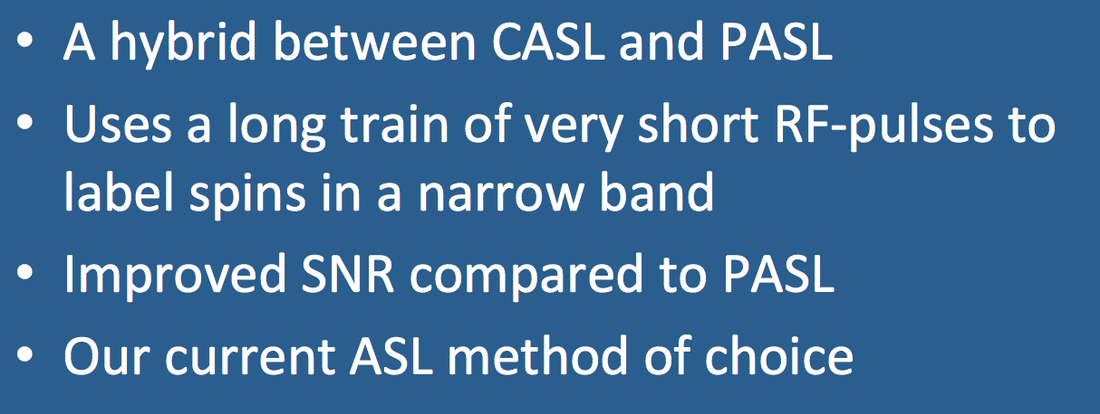 The pCASL technique with a narrow labeling band just
The pCASL technique with a narrow labeling band justproximal to the imaged volume
 pCASL pulse sequence. In the tagging portion the slice-select
pCASL pulse sequence. In the tagging portion the slice-selectgradient (Gz) is unbalanced, but balanced in the control.
Alternating RF-phase is also used in the control portion.
Advanced Discussion (show/hide)»
The idea that flowing spins can be selectively inverted by the combination of a radiofrequency (RF)-pulse AND a gradient is an interesting and unique feature of CASL and pCASL. The underlying physics is a little complex and introduces the concept of flow-related adiabatic inversion. Spin inversion in CASL and pCASL takes place by a different mechanism than in PASL, where a traditional adiabatic slab inversion pulse is applied that does not require flow for tagging.
The general adiabatic phenomenon has been previously introduced in a prior Q&A. In brief, adiabatic excitation is a special type of RF-stimulation that occurs only under certain limited conditions and produces a nearly perfect inversion of net magnetization (M) that is relatively tolerant to B1-field inhomogeneities. The phenomenon was described in the early days of NMR in which a specimen in a constant magnetic field was subjected to continuous RF-excitation swept over a range of frequencies from far below to far above the resonance frequency. Provided the B1-field was strong enough and applied slowly enough (the adiabatic condition), the net magnetization (M) could be nutated with a complete inversion by the end of the sweep.
Surprisingly, adiabatic inversion of flowing spins in ASL can occur even when the RF-field is maintained at a constant frequency and amplitude. This happens if a strong spatial gradient oriented in the direction of flow is applied concomitantly with RF-excitation. As the flowing spins move within this gradient their resonant frequencies change by location. What looks like a stationary RF-field to the outside world seems like a sweeping RF-field to the flowing spins. Thus they can undergo adiabatic following and inversion provided their velocities (v) are neither too small nor too large compared the T2 relaxation time of arterial blood, strength of the gradient (G), and magnitude of the effective field (≈ B1) according to the relationship:
Dai W, Garcia D, de Bazelaire C, Alsop DC. Continuous flow driven inversion for arterial spin labeling using pulsed radiofrequency and gradient fields. Magn Reson Med 2008; 60:1488-1497. (original description of pCASL)
Golay X, Hendrikse J, Lim TCC. Perfusion imaging using arterial spin labeling. Top Magn Reson Imaing 2004; 15:10-27. (Good review plus a description of ASL of variants and acronyms such as FAIRER, TILT, BASE, and others).
Kober F, Jan T, Trollen, Kayak KS. Myocardial arterial spin labeling. J Cardiovasc Magn Reson 2016; 18:22. (Primary focus is on the Look-Locker FAIR techniques most widely used in cardiac ASL)
Luh W-M, Wong EC, Bandettini PA, Hyde JS. QUIPSS II with thin-slice TI1 periodic saturation: a method for improving accuracy of quantitative perfusion imaging using pulsed arterial spin labeling. Magn Reson Med 1999; 41:1246-1254.
Petersen ET, Lim T, Golay X. Model-free arterial spin labeling quantification: approach for perfusion MRI. Magn Reson Med 2006; 55:219-232. (QUASAR method)
Wong EC, Buxton RB, Frank LR. Quantitative imaging of perfusion using single subtraction (QUIPSS and QUIPSS II). Magn Reson Med 1998; 39:702-708.
Can you briefly explain the difference between the various ASL methods? Which is the best?
